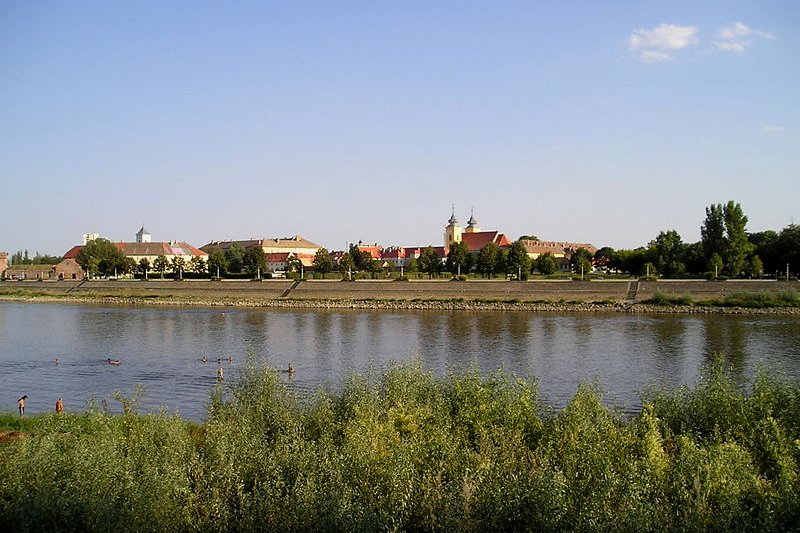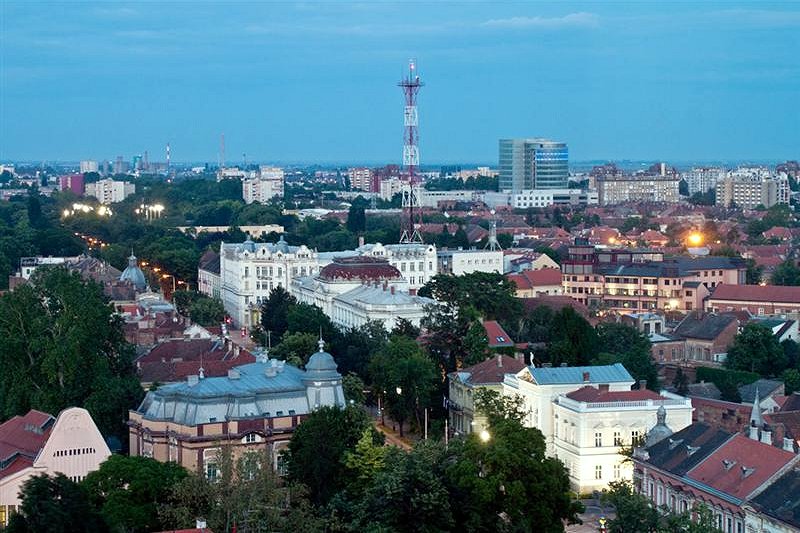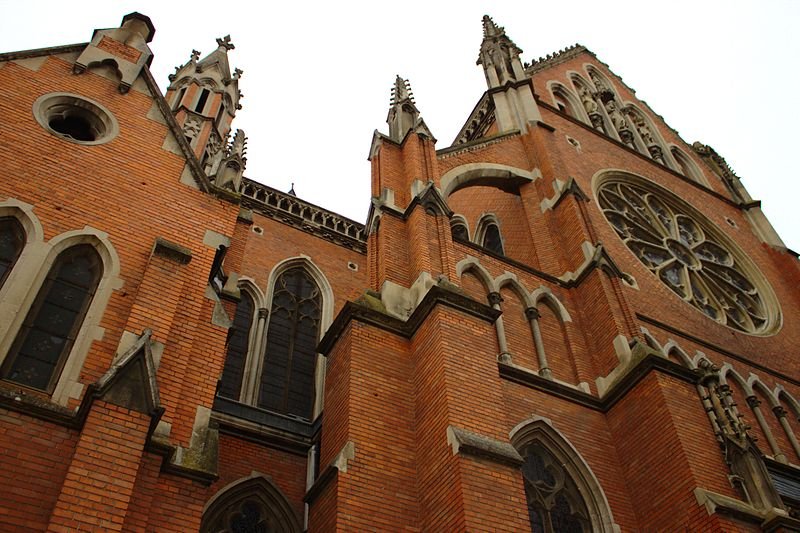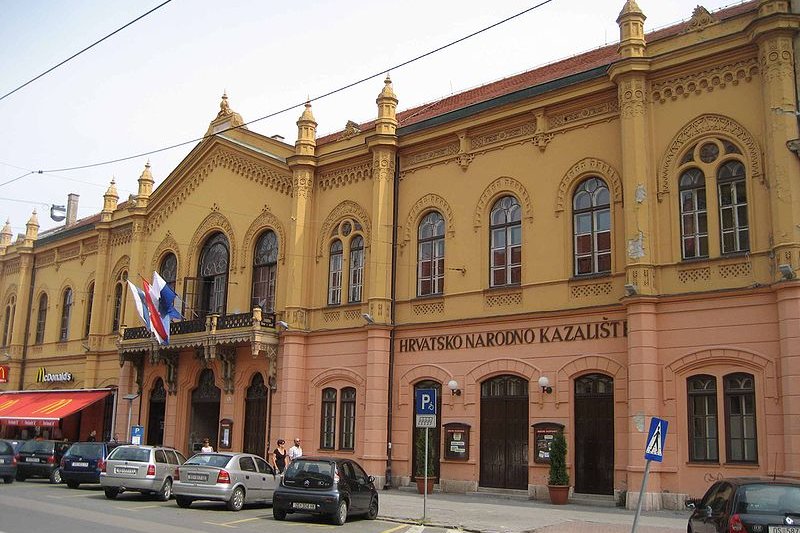 The Tvrđa district of Osijek
The Tvrđa district of OsijekSource: https://commons.wikimedia.org/wiki/File:Osijek_%28tvr%C4%91a%29.JPG
Author: Dtom

Osijek is a city on the northeastern part of Croatia. It covers 30 sq km (11.6 sq mi) and has a population of 108,000 (2011 estimate), making it the fourth largest city in the country.
Osijek is the main city in the region of Slavonia, which is in eastern Croatia. It is also the administrative center for Osijek-Baranja county. The city is located on the bank of the river Drava, about 25 km upstream from its confluence with the river Danube.
 Osijek, Croatia
Osijek, CroatiaSource: https://commons.wikimedia.org/wiki/File:Osijek_panorama.jpg
Author: VelikiMeshtar

The warmest month in Osijek is July, when the average high temperature rises to 28°C (82.4°F). Coldest month is January, when the average low temperature drops to -4.2°C (24.4°F). June is the wettest month, receiving precipitation totalling 81.8 mm (3.22 in).
Human habitation in the area around Osijek dates back to Neolithic times. In AD 131, the Romans established a settlement here called Mursa. It was destroyed in the Battle of Mursa Major in AD 351. After that Croat tribes moved into the area and started a new settlement, which they called Osijek, "ebbing water," because it was on high ground above flood waters.
 Church of Saints Peter and Paul, Osijek
Church of Saints Peter and Paul, OsijekSource: https://commons.wikimedia.org/wiki/File:Osijek,_%C5%BDupanijska,_chr%C3%A1m_III.jpg
Author: Aktron/Wikimedia Commons

The earliest recorded mention of Osijek appeared in 1196. The village was the feudal property of the Korogyi family from 1353 until 1472. Then in 1526, it came under Ottoman rule. The Ottomans rebuilt the Osijek in the Turkish style. In 1566, the Ottoman ruler Suleiman the Magnificent built an 8-km boat-bridge here. The boat-bridge was considered one of the wonders of the world.
In 1687, the Austrian Habsburg Empire captured Osijek from the Ottomans. They built a new fort in Osijek called Tvrđa. Under the Austrians, German-speaking settlers moved in to occupy Osijek. By the 19th century it had become the largest city in Croatia.
 Croatian National Theater, Osijek
Croatian National Theater, OsijekSource: https://commons.wikimedia.org/wiki/File:HNK_Osijek.JPG
Author: Modzzak

When Yugoslavia disintegrated, Osijek became part of Croatia. In the subsequent war from 1991 to 1995, it suffered a civilian casualty of over a thousand people, mainly due to bombings within the city. Now that peace has returned, the city is slowly restoring its old quarters, which are filled with charming medieval houses.
Visiting Osijek
Osijek is a rail and road transport hub for Croatia. You can easily take a train here from Sarajevo, Budapest, Koprivnica and Rijeka. There are also bus services between Osijek with all the major cities of Croatia as well as Belgrade, Pecs, and other surrounding cities.Places of Interest in Osijek
- Church and Monastery of St James (Sv. Jakov)
Built in 1702, this is the oldest building in the Upper Town. It includes a Capuchin monastery. - Church of Saints Peter and Paul Sv. Petar i Pavao
Church in the Neo-Gothic style dedicated to St Peter and St Paul. It is called a cathedral due to its size, although it actually isn't one. - Church of St Michael (Sv. Mihovil)
Church built by the Jesuits in the 18th century, on the site of the 16th century Kasim-paša mosque. - Church of the Holy Cross (Sv. Križ)
Church built by the Franciscans in 1709-1720 on the site of an earlier medieval church. It houses the first printing press in Slavonia in 1735. - Croatian National Theater (Hrvatsko Narodno Kazalište)
The national theater was built in the 19th century in the Moorish style. - Europe Avenue (Europska Avenija)
The main thoroughfare of Osijek, it runs from the Fort (Tvrđ) to Upper Town (Gornji grad). - Gallery of Fine Arts (Galerija Likovnih Umjetnosti)
Gallery established in 1954. It occupies a 19th century house. Paintings from the 18th and 19th centuries are exhibited here. - Museum of Slavonia (Muzej Slavonije)
Museum occupying the eastern wing of the Osijek Town Hall since 1946, it showcases exhibits related to the region. Among the objects on display include Greek, Illyrian and Roman artifacts.
 Latest updates on Penang Travel Tips
Latest updates on Penang Travel Tips
 Discover with Timothy YouTube Channel
Discover with Timothy YouTube Channel
 PG Food Channel
PG Food Channel
 Learn Penang Hokkien YouTube Channel
Learn Penang Hokkien YouTube Channel
 SojiMart Videos
SojiMart Videos
Latest from Discover with Timothy: Gurney Bay - what to see and do there
About this website

Hello and thanks for reading this page. My name is Timothy and my hobby is in describing places so that I can share the information with the general public. My website has become the go to site for a lot of people including students, teachers, journalists, etc. whenever they seek information on places, particularly those in Malaysia and Singapore. I have been doing this since 5 January 2003, for over twenty years already. You can read about me at Discover Timothy. By now I have compiled information on thousands of places, mostly in Peninsular Malaysia and Singapore, and I continue to add more almost every day. My goal is to describe every street in every town in Malaysia and Singapore.
Robbie's Roadmap
- Episode 1: Robbie's Journey to Financial Freedom
- Episode 2: Lost in America
- Episode 3: The Value of Money
- Episode 4: The Mentor
- Episode 5: The Thing that Makes Money
- Episode 6: The walk with a Billionaire
- Episode 7: The Financial Freedom Awakening
- Episode 8: Meet Mr Washington
- Episode 9: The Pizzeria Incident
Copyright © 2003-2024 Timothy Tye. All Rights Reserved.


 Go Back
Go Back